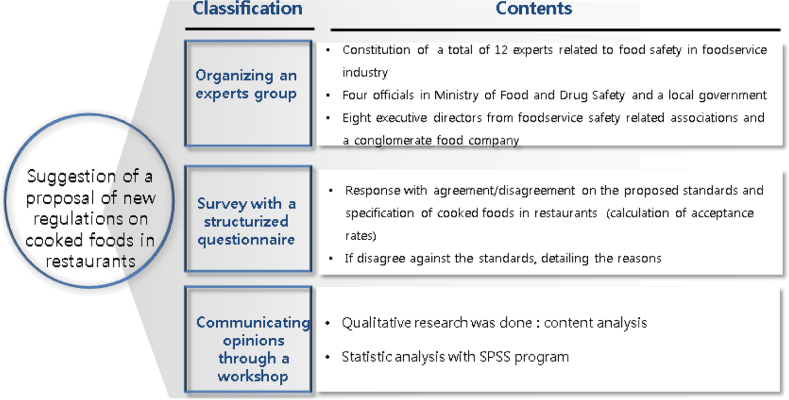J Nutr Health.
2016 Jun;49(3):201-212. 10.4163/jnh.2016.49.3.201.
Expert opinions on improvement of current food code related to hygiene management standards for cooked foods in restaurants
- Affiliations
-
- 1Department of Food and Nutrition, Dankook University, Yongin-si 16890, Korea. hjc10@dankook.ac.kr
- 2Division of Microbiology, Ministry of Food and Drug Safety, Cheongju 28159, Korea.
- 3Department of Foodservice Management and Nutrition, Sangmyung University, Seoul 03016, Korea.
- 4Department of Food and Nutrition, Yonsei University, Seoul 03722, Korea.
- KMID: 2328184
- DOI: http://doi.org/10.4163/jnh.2016.49.3.201
Abstract
- PURPOSE
Needs for reevaluation of food code standards and regulations for cooked foods produced in restaurants and institutional foodservice to minimize risk factors leading to foodborne outbreaks are on the rise. The purpose of the study was to propose updated standards for cooked foods of restaurants by testing whether or not experts agree to include them as a standard.
METHODS
Qualitative and quantitative research methods were applied via a survey by email and workshop hold for experts panel discussions.
RESULTS
Seven newly proposed standards were selected as follows: (1) sanitizing vegetables and fruits with no heating process after washing, (2) rapid cooling of cooked foods after heating process, (3) monitoring cooking temperatures, (4) minimum 2 hours holding after cooking for temperature control of safety (TCS) foods without temperature control, (5) banning practices for workers such as bare hands handling of ready-to-eat foods, (6) maintaining cleanliness of food contact surfaces for disposable products, and (7) cold holding standards for sushi.
CONCLUSION
The proposed proposal can be utilized as control measures for preventing foodborne illness in restaurants. However, a feasibility study should be conducted to test whether they are applicable to the field of restaurant operation.
MeSH Terms
Figure
Reference
-
1. Ministry of Food and Drug Safety (KR). The 2015 foodborne statistics: places caused by foodborne illness [Internet]. Cheongju: Ministry of Food and Drug Safety;2015. cited 2016 Apr 23. Available from: http://www.foodsafetykorea.go.kr/portal/healthyfoodlife/foodPoisoning-Stat.do?menu_no=519&menu_grp=MENU_GRP02.2. Shin H, Lee S, Kim JS, Kim J, Han KH. Socioeconomic costs of food-borne disease using the cost-of-illness model: applying the QALY method. J Prev Med Public Health. 2010; 43(4):352–361.
Article3. Kwak TK, Kang YJ, Rye K, Moon HK, Chang HJ, Lee KE, Choi JW. Food safety principle and practice. Food safety principle and practice. Paju: Gyomoonsa;2014.4. The 2014 foodservice position and 2015 forecasts. Hotel Restaur. 2015; 287:101–143.5. Gregoire MB. Foodservice organizations: a managerial and systems approach. 7th ed. Upper Saddle River (NJ): Prentice Hall;2010.6. Shin SK. Improvement of operation system for technical regulation of foods [Final reports of the Ministry of Food and Drug Safety]. Seoul: Hanyang Women's University;2013.7. Ministry of Food and Drug Safety (KR). Food safety management manual for restaurants. Cheongju: Ministry of Food and Drug Safety;2014.8. Chang HJ, Ju SY, Heo EJ, Kim SH, Kwak TK, Hong WS. Qualitative analysis of current food code for the improvement of hygiene management practices in restaurants and institutional foodservice premises by comparing standards and guidelines of the developed countries. J Foodserv Manage. 2016; 19(3):7–24.9. Ministry of Education (KR). School meal code enforcement rule [Internet]. Cheongwon: Ministry of Education;2013. cited 2015 Mar 30. Available from http://www.law.go.kr/lsInfoP.do?lsiSeq=146542&efYd=20131123#0000.
- Full Text Links
- Actions
-
Cited
- CITED
-
- Close
- Share
- Similar articles
-
- Study on the Establishment of Nutrient Requirements for Commercial Supplementary Foods for Infants and Young Children
- Hygiene Monitoring of Food for Children’s Foodservice Using the IoT-based Smart Food Safety Management System (iMEAL)
- Comparison of dietary habits, perception and consumption frequency of fast foods between youths working part-time at fast food restaurants and other food-related services
- A survey on customers' perception of a hygiene grade certification system for restaurants
- Factors contributing to the reduction of sodium intake by food manufacture and cooking venues according to the national sodium reduction policies


